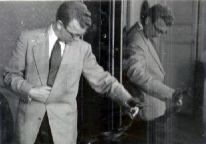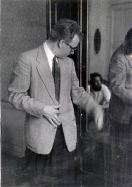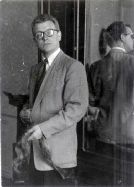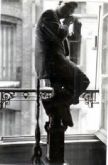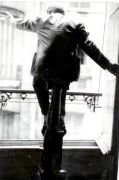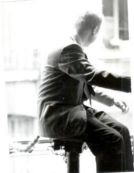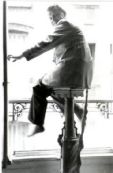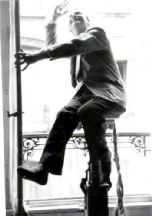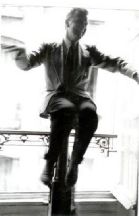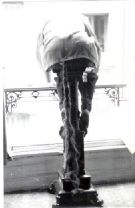Milking the Moon (33 page)

*
There was this crazy man in Paris who was the heir of Maria Sert. She was the widow of the Spanish painter José Sert, who collected medieval stuff. He restored a lot of murals in medieval monasteries and churches all over Spain, and instead of taking money—since he was independently wealthy—he’d ask if he could have an old chest or an old crucifix or an old tapestry, and he had a collection that was just unbelievable. He left it to his wife, and then his wife gave it to this funny little Frenchman who looked like an enlarged tadpole. I can’t think of his name. He took drugs. In the middle of a dinner or a cocktail party at his house, he’d suddenly start looking pale and tired. Then he’d run out of the room and come back looking all fresh.
It was at one of his parties that I met Greta Garbo and the old guy with the dead white face and eye makeup who was the original of Mighty Grain of Salt O’Connor in Djuna Barnes’s
Nightwood.
Garbo was introduced as Harriet Brown. That’s the name she went under. I also met her longtime lover, Mercedes de Acosta. I’m not sure, but I think Garbo was what we in the Old South called nympho. In other words, she didn’t have a stamp collection. Some people have stamp collections. Some don’t. Mercedes looked like a Madrid madam of 1890. A little fleshy, a little flabby, dyed black hair. I mean hair dyed so black that it was like a black hole in space. Big black eyes and a lot of black eye makeup and red lipstick. I mean lipstick they don’t make anymore. They haven’t made it since they closed the whorehouses in Madrid.
And the things in that apartment. His bedroom was about as big as a house. It was papered with studies of oil on canvas that Rubens had made for one of the famous tapestries. That’s what he had for wallpaper. The dining room had a sixteenth-century Chinese table that had a top made of the scales of deep-sea turtles arranged in a fan shape. Then on the sideboard there were these temple guardians: one-third cat, one-third dog, one-third dragon. Not even the Met has anything like it. There was an old marble fireplace, but you couldn’t see it because sitting in front of it were natural crystal formations from some unknown part of the globe.
We talked a lot, and it came out that I loved Tiepolo because of those drawings of Pulcinella. “Oh,” he said, “come with me.” We went into this little room that only had a wall of little drawers. In the little drawers were nothing but Renaissance to 1800 drawings, drawer after drawer after drawer. And a little table and a little magnifying glass. He left me there for about an hour before lunch one day, and if somebody hadn’t come to get me, I might still be there. They might have found this skeleton of a fairly youngish man just leaning over a table of drawings.
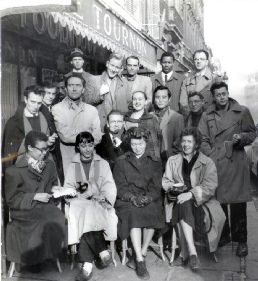
Group photograph taken outside the Café de Tournon in Paris in the mid-1950s. In the front row, from left to right: Vilma Howard, poet; Jane Lougee, publisher of
Merlin;
Muffy Wainhouse, wife of Austryn Wainhouse; Jean Garrigue, poet. In the second row: Christopher Logue, poet and
Merlin
editor; Richard Seaver,
Merlin
editor; Evan Connell (with mustache), novelist; Niccolo Tucci, essayist and novelist; Eugene Walter; a young woman known as “Gloria the Beautiful Cloak Model”; Peter Huyn, poet, translator, and editor; Alfred Chester, novelist and short story writer; Austryn Wainhouse,
Merlin
editor. In the last row: George Plimpton,
Paris Review
editor; Michel van der Plats of
Het Vaderland,
a Dutch publication; James Broughton, filmmaker; William Gardner Smith, novelist; Harold Witt, poet. (© Van Noppen)
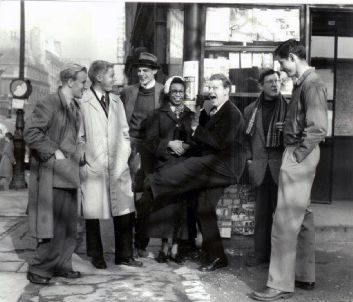
Eugene, again with members of the
Paris Review
crowd, this time dancing in the street in an attempt to make novelist Evan Connell smile and prove he’s not just “an old Hamlet.” From left: Michel van der Plats, William Pène duBois, George Plimpton, Vilma Howard, Eugene Walter, Alfred Chester, and Evan Connell. (© Van Noppen)
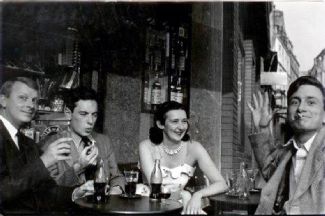
From left: Eugene Walter, David Hughes, Catherine Morison, and her husband, Julian Cooper, at a café in Paris, 1950s.
(photographer unknown, courtesy of Katherine Clark)
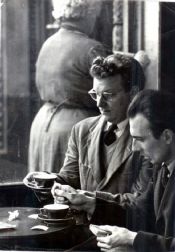
Eugene Walter and Christopher Logue at a café in Paris, 1950s. (photograph by Russ Melcher)
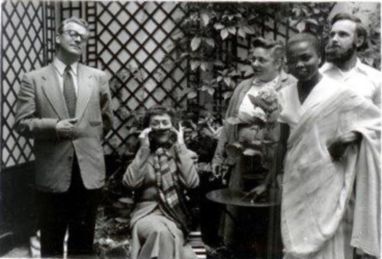
From left: Eugene Walter, Jean Garrigue, Gurney Campbell, Lady Angela Lady, and Jack Campbell. Note that Jean Garrigue is wearing as a mustache the braid Eugene stole from Julia Randall. (photographer unknown, courtesy
of Katherine Clark)
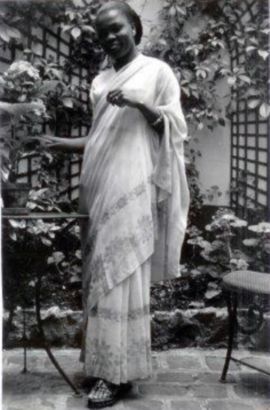
Lady Angela Lady, an African princess from the Gold Coast, Paris, 1950s. (photographer unknown, courtesy of Katherine Clark)
